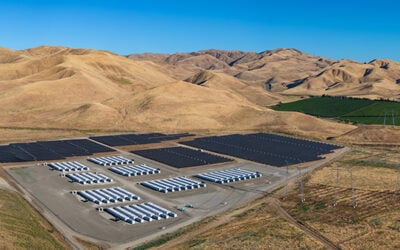
From the US, Maxwell Technologies is acquired for its third time, by Clarios, Fullmark Energy completes a tax credit transfer, and OATI partners with Colville Tribes on microgrid solutions.
Clarios acquires Maxwell Technologies
Technology firm Clarios has acquired ultracapacitor-based energy storage manufacturer Maxwell Technologies in a deal with undisclosed terms.
Clarios will operate Maxwell Technologies as an independent US-based business unit.
Clarios explained that supercapacitors charge and discharge energy almost immediately, making them ideal for storing surplus energy and assisting systems during sudden peak demand spikes.
Try Premium for just $1
- Full premium access for the first month at only $1
- Converts to an annual rate after 30 days unless cancelled
- Cancel anytime during the trial period
Premium Benefits
- Expert industry analysis and interviews
- Digital access to PV Tech Power journal
- Exclusive event discounts
Or get the full Premium subscription right away
Or continue reading this article for free
They can reportedly endure up to 1 million charge cycles, function effectively across a wide temperature range from -40°f to 149°f (-40°c to 65°c) and require no maintenance or fire-risk safeguards.
The company further highlighted that Maxwell’s supercapacitors will help the company build a stable supply chain to support the US, while complementing Clarios’ low-voltage solutions.
Tesla acquired Maxwell in 2019. At that time, Taavi Madiberk, CEO of Skeleton Technologies, a European manufacturer of ultra- and super capacitors said, “Mr. Musk studied ultracapacitors in Stanford during his PhD, but he is underestimating the R&D hell to get to higher energy density ultracapacitors.”
In July 2021, Tesla sold Maxwell Technologies’ brand and ultracapacitor business to Ucap Power, a San Diego–based startup led by Gordon Schenk, who was previously vice-president of sales at Maxwell.
However, Tesla reportedly retained the dry battery electrode manufacturing process that Maxwell was developing before its acquisition. That process is thought to enable cost and performance improvements in electric vehicles (EVs).
Mark Wallace, CEO of Clarios, noted of its acquisition of the company:
“This integration strengthens our ability to serve our automotive customers and creates a long-term opportunity to expand our presence in non-automotive sectors. Maxwell’s existing customer relationships in Data Centres, Grid, Military and Industrial applications will be maintained and actively developed under Clarios’ leadership.”
Fullmark Energy announces US$46 million ITC transaction
IPP Fullmark Energy has announced the Investment Tax Credit (ITC) transfer of US$46 million to a buyer in the industrial sector for its operational 125MW/290MWh Redwood battery energy storage system (BESS) projects portfolio.
The final project in the Redwood portfolio, the 65MW/130MWh San Jacinto BESS in Banning, California, reached commercial operations earlier this month.
The Johanna BESS project in Santa Ana, with a capacity of 20MW/80MWh, commenced commercial operations in October 2021. Meanwhile, the Desert-Carris project in Palm Springs and the Ortega Project in Lake Elsinore, each with a capacity of 20MW/40MWh, both became operational earlier this year.
The three 2025 projects add a total of 105MW of new capacity to the California utility Southern California Edison’s distribution system.
Fullmark closed the US$46 million ITC transfer following the portfolio’s commercial operations date (COD).
The company stated that the ITC transfer will improve its financial flexibility, enabling faster development of energy storage projects and strengthening operations throughout the Redwood portfolio.
Accounting and advisory firm BDO USA served as the tax credit transfer advisor on the transaction; the company also assists with the generation, compliance, and monetisation of tax credits.
In January 2023, Fullmark Energy secured approximately US$100 million in funding for the Redwood Projects through a combination of a term loan and a letter of credit.
Chris McKissack, CEO of Fullmark, noted the ITC as a strength of the Inflation Reduction Act (IRA), saying that it is “creating tangible pathways for infrastructure investment in American communities.”
The One Big Beautiful Bill Act restricts tax credits if a component is produced through “effective control” by a specified foreign entity. Starting in 2026, 55% of a project’s costs must originate from non-prohibited foreign entities, rising to 75% by 2030 and thereafter.
Time will tell how often companies are able to obtain and transfer investment tax credits, as Fullmark has done with this portfolio.
OATI and Colville Tribes partnering for tribal energy sovereignty
The Confederated Tribes of the Colville Reservation (Colville Tribes) and Open Access Technology International (OATI) have announced a partnership to promote tribal energy sovereignty and resilience by designing and deploying several microgrids across the reservation.
The Colville Tribes Reservation is located in Washington state, and according to OATI, it experiences frequent power outages, particularly during winter storms and extreme heat. Residents often pay between US$500 and US$600 a month for power.
OATI further states that the Colville Tribes microgrid programme is “rooted in the principle of energy sovereignty—the right of tribes to produce, deliver, and manage energy on their own lands.”
With multiple utilities serving the Colville Reservation at different service levels, self-generation of electricity can enhance resilience and reliability for vulnerable communities.
The Colville Tribes can also utilise the microgrids to provide extra benefits to local utilities or participate in expanding energy markets while powering critical services such as healthcare, commerce, and housing.
The programme aims to enhance reliability, minimise outages, and ensure long-term energy independence for the Colville Tribes, which are divided into four legislative districts: Omak, Nespelem, Keller, and Inchelium.
Supported by federal and state grants, the initiative also looks to address vulnerabilities such as winter storm interruptions and wildfire dangers.
OATI will deploy its GridMind platform with the microgrids to support the projects through resource management and market integration.
The designated sites include Nespelem HQ Campus (Lucy F. Covington Government Centre), which features rooftop solar PV, battery storage, EV charging stations, and microgrid controls, with plans to expand and create a comprehensive campus resiliency hub.
Paschal Sherman Indian School (PSIS) will have a community microgrid designed to support both education and community resilience.
Keller and Inchelium Districts will add more distributed energy resources and microgrid infrastructure to strengthen local resilience.
Future expansions plan to incorporate gaming operations and possibly data centres, leveraging tribal-owned utility and telecom infrastructure.
There is a trend with microgrid providers to partner with native communities to deploy systems on their land.
In May, zinc hybrid cathode battery and storage system maker Eos secured an order with Faraday Microgrids to deploy a 3MW/15MWh system on tribal land in California.
Paired Power joined the Preferred Provider Programme of the Alliance for Tribal Clean Energy, an Indigenous-led 501(c)(3) nonprofit supporting Native American tribes in transitioning from extractive industries to renewable energy systems.
As part of the agreement, Paired Power and PHNXX became officially authorised to deliver clean energy solutions, such as microgrids, to Native American and Aboriginal tribes.
The Chairman of the Confederated Tribes of the Colville Reservation, Jarred-Michael Erickson, said of the partnership with OATI:
“Since the Colville Reservation is in a remote location, subject to natural events like winter storms and fires, it has always been difficult for us to sustain a reliable supply of power. Our hope is that this microgrid technology will not only keep our lights on, but will also position us for new economic opportunities.”





